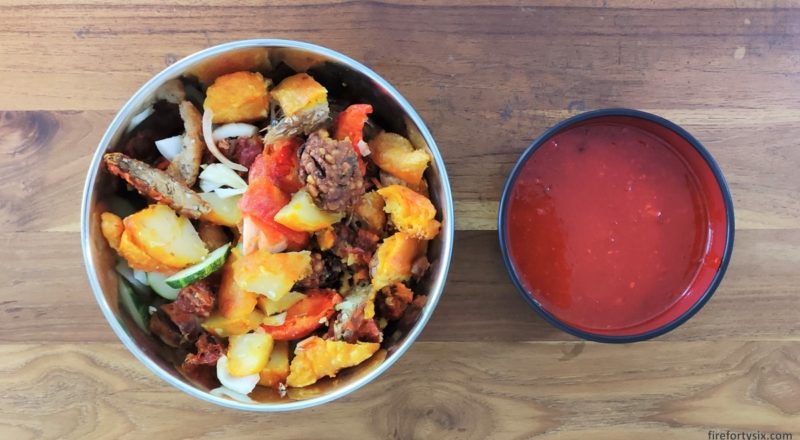Abdhus Salam is a second generation Indian rojak hawker with a stall named after him. This four minute clip tells his story.
His stall “in a food court within a shopping centre” looked familiar and I remembered that when we saw it, we said that we should give it a try. And after hearing his story and seeing his pride and effort in making his food, we definitely had to.
If you’re ever in the B2 foodcourt of Northpoint City, which is connected to the Yishun MRT station, definitely check out Ministry of Rojak. Co-incidentally, The Wife had a meeting nearby and made a detour to dabao some home for dinner.


The selection was wide and consisted of various multi-coloured fried fritters. The number one thing I always choose when having Indian rojak is the fried potato. I can’t explain why, I just like it.


She chose the usual suspects, including my fried potato, plus a long piece of tempeh and some lentil-vadai-thing. She got lucky number 18 as her queue number and waited as they deep-fried everything (again) and chopped them up in bite-sized pieces. Oh, and if you haven’t realised by now, Indian rojak is not the healthiest of foods.


I reheated everything in our trusty air fryer and poured out the generous packet of dipping sauce, which looked generic but was absolutely wonderful. It had the right consistency, enough to coat everything nicely but not too cloyingly starchy. The spice level was just nice for me (meaning, quite spicy) and even though you can’t quite see it from the photo, it was full of crunchy peanut bits.


I didn’t care much for the tempeh and lentil-vadai-thing (though The Wife liked them) but the potato was good. But the stand outs that night were definitely the two pieces of prawn fritters, one orange and one red.
We’re used to having soggy fritters with dried-out prawns, but these were fluffy with surprisingly juicy pieces of prawns. In the video clip above, he says that he makes everything fresh, and it definitely shows in the final product.
Indian rojak is not something that we eat often, but this was the best that we’ve ever had and we would definitely buy it again the next time we’re in Yishun. Their takeaway plastic bag states that their original store is in Ayer Rajah Food Centre, and it might be worth a visit to compare the two.

The rojak that we do have more frequently is the Chinese version. You could argue that it’s healthier, since it’s technically a fruit salad, but I wouldn’t make that argument myself. The usual place that we buy it from is Soon Heng Rojak in the HDB Hub foodcourt connected to the Toa Payoh bus interchange.
It’s almost impossible to identify the ingredients when you look at the dish, but it includes raw thick-cut slices of turnip, pineapple, green mango, cucumber plus some cuttlefish, blanched taugeh, kangkong, grilled taupok and youtiao.


The old uncle making it starts by plopping a big blob of prawn paste (hae gor) into his huge mixing bowl, and then scoops in white sugar and squeezes in the juice of a few limes. He then finely dices some torch ginger flower, adds them to goopy sauce and gives it a stir to dissolve the sugar.
The rest of the ingredients then go in one-by-one and mixed until everything is coated with the black viscous sauce. He then scoops in ridiculous amounts of coarsely ground peanuts, more than what you’d normally get from other stalls.
This final step makes a big difference when you order takeaway, because the raw fruits and vegetables leak their juices and usually make the sauce too watery by the time you reach home. The ground peanuts help to soak up the excess liquid and keep the sauce nice and goopy.
The diced torch ginger flower also gives the entire dish a uniquely wonderful taste, and is something that only the good Chinese rojak stalls include.
Peak lunch and dinner queues are usually crazy long, so we only buy when we’re there during off-peak timings when we don’t have to wait too long. The photos below were taken pre-pandemic, in case you were wondering why people weren’t masked up.


One thing that always makes me slightly uncomfortable whenever I’m at the HDB Hub foodcourt is the roving tray return robot. It wanders around and gently reminds you to return your used tray into its stomach (?).
I think it’s the eyes that freak me out a bit, and the fact that it kind of follows you around as you walk. But that could just be my over-active imagination. When the singularity happens, I hope that it remembers that I return my trays diligently and treats me with kindness.

Rojak is a common dish across South-east Asia, especially Singapore, Malaysia and Indonesia, but there are many different interpretations. The most common one in Singapore is probably the Chinese version, followed by Indian rojak and Malay gado-gado.
It’s not a dish you’d typically find in fancy restaurants, but you will definitely find it in many hawker centres and food courts in the heartlands of Singapore. And if you happen to come across a tray return robot, remember to greet it warmly to earn some good karma.
Because, you know, in case Skynet.
